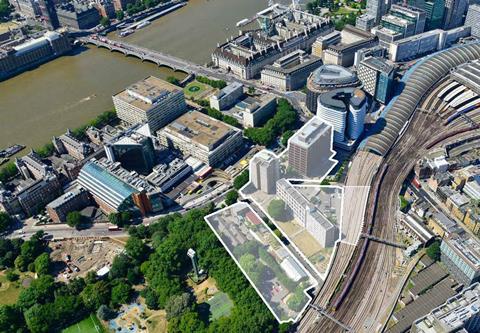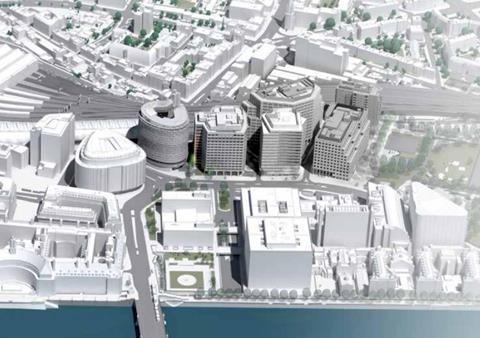Development due to be built next door to Waterloo station
Stanhope’s plan for a huge mixed-use scheme opposite St Thomas’ Hospital has been recommended for approval by Lambeth planners next week.
The Royal Street development site runs across 5.5 acres of land and buildings either side of Royal Street and Upper Marsh close to Waterloo station.
Stanhope and US funder Baupost is developing the scheme for Guy’s and St Thomas’ Foundation and will see new public realm, space for businesses, restaurants, shops, and homes as well as laboratory space for new healthcare technologies.

It would include the demolition of several existing buildings on the site and their replacement with five residential and office blocks ranging from 12 to 16 storeys in height.
Practices working on sections of the AHMM masterplan include Henley Halebrown, Morris & Co and Piercy & Co.
Telling councillors to back the scheme, the officer said it had been designed to a “very high standard by leading architects” – but admitted it would cause townscape harm to nearby heritage including the Palace of Westminster World Heritage Site, Lambeth Palace and Archbishop’s Park.
If granted approval, the scheme will be referred to the Greater London Authority for stage two approval by the London mayor.
But it would also need final sign off from communities secretary Michael Gove, as Historic England has held up an objection over the scheme’s heritage impact.
In May, Gove put a block on Make’s plans for a huge redevelopment of the former ITV studios on the nearby Southbank, located on the same side of the river Thames as the Royal Street site. A public inquiry into that scheme starts today after it was called in by Gove’s successor Greg Clark in early September.
>>See also: In business with Stanhope’s Laura Collins and Tony Wall
Concerns about Royal Street have been raised by Westminster council who said the plans would have an “unacceptable” impact on the setting and views of the Palace of Westminster, while the International Council on Monuments and Sites said it would “compromise the stature” of Big Ben by obscuring the sky in views looking south.
Among the buildings set for the wrecking ball under the plans include the office of Feilden Fowles.
The practice is part of the wider design team and is behind plans for a sixth plot on the site which would see the railway arches of the 19th century Waterloo viaduct converted into office space.

Other buildings facing demolition include the 1957 Corbusier-inspired Canterbury House, designed by St Thomas’ Hospital architect Leslie G Creed, and the 14-storey Stangate House, designed by William Fowler Howitt and built in 1964.
Becket House, a 1974 polished granite-clad office building designed by Yorke, Rosenberg and Mardall, would be substantially expanded under plans by Morris & Co with two trapezoidal wings added to the block’s east and west sides.
Heritage group the Twentieth Century Society unsuccessfully lobbied Historic England to get all three buildings grade II-listed last year but the latter concluded they were not listable and recommended certificates of immunity.
The plans would replace the site’s existing 129 private rented homes with 133 new homes, 50% of which would be affordable, along with 160,000 sq m of office space, around 4,000 sq m of retail space and a 650 sqm gym.
The intention is to create a mixed-use development to support a lifesciences innovation district focusing on medical technology, a proposal backed by a partnership between King’s College London, King’s Health Partners and Guy’s and St Thomas’ NHS Foundation Trust.



























No comments yet